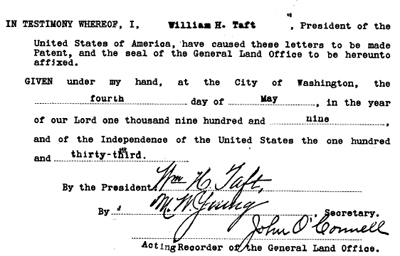|
History: Homestead Act factored into early LL settlement
10/3/2012 9:57:05 AM
 Image courtesy of the Liberty Lake Historical Society This excerpt from a land patent dated May 4, 1909, was for property near the Spokane County ORV park off the southeast end of Liberty Lake. The homesteader was Andrew Knudsen, uncle to current Liberty Lake resident Ron Knudsen. |
Liberty Lake Historical Society
Supporters of the Homestead Act held the belief that the availability of free or cheap land, under the right terms, would ease the burden of the lack of land in states along the eastern U.S. It would promote the settlement of the west and help form new states. This, in turn, would generate federal income to help run the Republic, while providing opportunity to any citizen willing to take up farming.
From 1830 to 1860, several homestead proposals were brought before Congress. These bills lacked the votes to pass largely because the southern states saw the west as a place to expand their plantations operated with slave labor. With the secession of the southern states in 1861, the Homestead Act easily passed, and Abraham Lincoln signed it into law in May 1862. The passage of this law was met with great optimism, especially for those who had the courage and willingness to do hard work.
A few significant events along with the Homestead Act made Liberty Lake and the surrounding area favorable for settlement over the next two decades. These included the Indian Peace Treaties of 1858, the completion of the Mullan Road in 1862 and the Pacific Railroad Acts of 1863 to 1866 which encouraged the developments of the nation's railroads.
The requirements of the Homestead Act were few but sometimes daunting, especially in remote areas. Getting to the Homestead site was a challenge in itself. The Mullan Road facilitated access to this area from both directions. Pioneers traveling on the Oregon Trail could connect to the Mullan Road in Walla Walla, Wash.; whereas those coming by way of the Missouri River could connect at Fort Benton, Mont. By 1883, you could travel to this region on the Northern Pacific Railroad.
A homesteader needed only to be the head of a family or at least 21 years of age to claim a 160-acre parcel of land. Potential homesteaders came for many different reasons and from many different states and countries. If you were not already a citizen, only Declaration of Intention to become one was required to make a claim. Immigrants, including Danes, Norwegians and Germans, comprised a notable percentage of the Liberty Lake area's homesteaders. They immigrated from countries including Canada, Denmark, Norway, Germany and Austria. After they lived on the land, made certain improvements, farmed for five years and attained citizenship (if they were not already), homesteaders were eligible to prove their claim.
To start the homesteading process, a person had to file their intentions at the nearest land office. The land agent checked the plot of land in question for previous ownership claims. If the land was available, a filing fee of $10 was paid to temporarily claim the land along with a $2 commission to the agent. The homesteader then returned to the land to begin improvements, which included building a home and cultivating a portion of the land. At the end of the process, the person had to prove and be verified by two credible witnesses that all requirements had been met. If successful, a $6 fee was paid with the final form, and the homesteader received a patent for the land.
The home was usually one of the first improvements made. It needed to be a minimum size and have at least one window. These dwellings could be constructed out of a variety of materials from sod to logs. In the Inland Empire, there was a ready supply of trees so most of the early homes were built out of logs. As sawmills developed to meet the demands of the railroads and growing communities, cut lumber became the building material of choice.
|
DID YOU KNOW?
• You can research documents from original Liberty Lake Homesteaders under the website www.glorecords.blm.gov/search. Liberty Lake is in Township 25 North and Range 45 East.
• 270 million acres, or 10% of the area of the United States was claimed and settled under the Homestead Act. • The average home built under the Homestead Act was 10 by 20 feet. • Some of the requirements under the Act were unclear, which made the homesteading process ambiguous and, at times, corrupt. • Stephen Liberty was one of Liberty Lake's original homesteaders. Genesis of Liberty Lake A series from the Liberty Lake Historical Society, appearing in the first Splash issue of each month in 2012.
January: Geology of Liberty Lake
February: Coeur d'Alene Tribe
March: 150 years of Gathering, Recreation and Music
April: Indian Wars, Part I
May: Indian Wars, Part II
June: Chief Seltice
July: Tecomtee
August: Peter Wildshoe
September: Mullan Trail
October: Homestead Act
November: Spokane Bridge Crossing
December: Stephen Liberty
|
During the 19th century, irrigation of crops was not practical on a large-scale basis, because it would take too much human labor. Farmers had to rely on what nature supplied. Our region annually averages 16.67 inches of precipitation, which is less than 45 percent of what the state of Ohio averages. This difference has a dramatic impact on the yield the crops produce. Because of this, it was a real challenge for many of the homesteaders in this region to live off the land. Advances in dry-land farming in the 1870s and 1880s helped in this regard, but not enough for the sandy, rocky soil around Liberty Lake.
To survive, most homesteaders in our area needed additional sources of income. Along with working their homesteads, many worked additional jobs. Some worked in lumber mills providing railroad ties to the expanding railroads. Others taught school, delivered supplies or worked for the government performing land surveys or carrying mail. Homesteading was both physically and emotionally difficult. About half the homesteading claims were successful nationally. But those who did survive provided much of the spirit and inspiration upon which our great country was built.
Ross Schneidmiller is president of the Liberty Lake Historical Society and a lifelong resident of the community.


